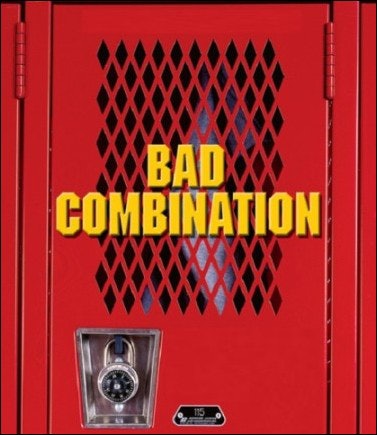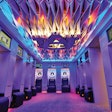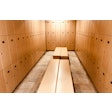Heavy use, moisture - and especially vandals - can frustrate facility owners hoping to get high performance out of their lockers

The best lockers are metal - strong, solid, secure. Except that the best lockers are plastic, which are impervious to the moisture common in locker rooms. But then, of course, the finest locker rooms almost invariably feature lockers made of wood, which are aesthetically pleasing, both visually and aurally.
The same goes for lock mechanisms. The best method of securing lockers is to require users to provide their own combination locks, as it shifts an administrative burden away from overworked staff members. Then again, providing locks, whether opened with combinations, keys, cards or coins, gives facility owners another source of needed revenue.
The best lockers and locker systems. It really depends on the person doing the buying, the particulars of a specific facility's design and the level of oversight in locker areas - among other factors, such as budget. The best low-priced lockers might be perfect for one kind of facility and unacceptable to another.
These simple truths were on our collective mind this spring as we set about trying to gauge AB readers' satisfaction with their locker systems. An informal survey, sent via e-mail to a random sample of high school, college recreation, public recreation/YMCA and health club professionals, garnered a response rate that might suggest widespread indifference to lockers in general. However, those who did respond had much to say about their lockers' ability to withstand almost constant abuse.
Metal lockers were the clear market share leader, making up 75 percent of the sample. Laminate lockers were next (14 percent), followed by wood (8 percent), plastic (2 percent) and phenolic (1 percent). Not surprisingly, metal dominated all categories except health clubs, where laminate led with 46 percent, followed by metal (29 percent) and wood (25 percent).
On the whole, respondents are satisfied with their lockers' performance. With the exception of three subcategories (metal in scratch resistance and noise-reduction quality, and wood in scratch resistance), all locker materials rated fairly well, and consistently so. (The other categories rated were moisture resistance, maintainability and longevity.)
Still, 41 percent of respondents said they would change their lockers if they could, and 24 percent said they'd like to change their locking system. Their locker troubles run the gamut, from problems with moisture (take your pick: rust or delamination) to sizing issues (some complained that their lockers do not take into account the huge gym bags patrons tend to carry these days). Metal lockers, the industry's biggest seller, lagged in four of five categories (see "Good Lock," p. 83), but no locker type escaped criticism of some kind.
What really became clear was that most respondents - a notable exception being those with laminate lockers in high-humidity areas - blamed problems not so much on locker materials or locking systems, but on the impact of vandalism in the locker room. Every kind of locker, it seems, is vulnerable to thieves.
The locker theft problem is widespread. Scan recent police reports and newspaper accounts, and you'll find incidents occurring week after week in community after community:
• June 21, Pelham Manor, N.Y. Personal papers are stolen from a man's locker at the Omni Health and Fitness Complex.
• June 13, Irvine, Calif. Two diamond rings are stolen from a locker at the Sporting Club.
• June 7, Orlando, Fla. Gold and diamond jewelry, a calculator and a watch are stolen from a gym locker during dance tryouts at Deltona High School.
• May 30, Fairfax, Va. Two wallets are stolen from lockers at two different gyms.
• May 23, Providence, R.I. A student is charged in a string of 11 thefts (netting $508) from Smithfield High School lockers.
• May 21, Warrenville, Ill. Four separate thefts from lockers at a fitness center net thieves more than $780 in cash, a watch, a bracelet and several credit cards.
• May 18, Annapolis, Md. A $6,000 watch is stolen from a locker at Gold's Gym.
Larger-scale criminal activity also appears to be on the rise at every type of facility. The Brooklyn (N.Y.) South police precinct reported in June that 65 thefts had taken place in health clubs (most at Bally Total Fitness clubs) within the previous 18 months. In May, the Poway, Calif., Unified School District announced a new emphasis on surveillance after a year in which 230 separate acts of locker vandalism and theft occurred, causing $133,350 in vandalism damage alone. And in April, in the Boston area, a seven-person theft ring was finally cracked by the state's Secret Service Financial Organized Crime Task Force. The thieves, a group of friends, typically used one-day passes to get into upscale health clubs, where they stole credit cards from lockers and purchased hundreds of thousands of dollars worth of merchandise that was then traded for cash or drugs. One of the suspects assaulted two undercover police officers who caught him breaking into lockers.
Locker break-ins are of two general types: Those in which the locker is forcibly opened and damaged, leaving no doubt that a crime has occurred, and those in which light-fingered thieves carefully open lockers and remove valuables. Sometimes very carefully: What made the thieves in the Boston ring so hard to apprehend was their selectivity. Many health-club users would find just one credit card or a couple of bills missing - leaving some doubting whether their loss occurred at the club.
Michael Davanzo, athletic administrator for Medina (Ohio) City Schools, says his district experienced the more violent brand of theft - repeatedly.
"We had metal half-lockers that had diamond-shaped vents on the front that were large enough for fingers to fit through," says Davanzo. "The way they were designed, students were able to bend the bottoms out and steal stuff with the padlocks still on the lockers. We ended up having to put wood on the bottoms of all the lockers to cover all the holes - and now we're getting new lockers."
As Davanzo notes, his locker problems haven't been limited to that particular design. He previously had tall lockers whose lock mechanism consists of three catches inside a handle that the user slides upward to open. Students had two standard methods of breaking in: Repeatedly yank upward on the handle (locks would occasionally loosen up enough to open), or place a small object at the bottom of the latch slot that prevents the bottom catch from latching (locker contents could be removed through the gap). But the destruction of the half-lockers hurt particularly, because they were the ones Davanzo had wanted all along and specified at his first opportunity.
"The manufacturer's rep who sold them to me hung on them to show me how strong they were," he recalls. "I was kind of surprised when things turned out the way they did."
Ruth Olsen's metal lockers suffered a slightly more subtle, but equally devastating attack, one that took months of sleuthing and retrofitting to understand and respond to. Olsen, director of intramurals and coordinator of the student recreation center at the University of Alaska-Fairbanks, had a "tremendous problem" with thieves who opened unused lockers and bent latching pins in the locker doors. Returning after the lockers were in use, they would then give a yank and open the still-locked lockers. Unlike what occurred in Medina, Alaska-Fairbanks' students would return to a locker that was still locked and seemingly undisturbed, only to find their wallets, purses and jewelry gone.
Olsen first set up a sting to trap what she assumed was one smart and strong perpetrator. She posted a sign saying that one of the locker rooms was temporarily closed for maintenance, and rigged a silent alarm on a locker door, behind which was planted a wallet containing permanent ink. Caught red-handed by a waiting officer, the suspect eventually fled the courthouse at his arraignment through an emergency door and was on the lam for the next three months.
In the meantime, Olsen enlisted the help of the locker manufacturer to find a solution to the problem latches. The manufacturer sent replacement latch pins, as well as small metal plates to cover them. Over the next several months, Olsen's staff replaced all the bent pins and installed the new pin guards, after which - with the suspect again in custody - the vandalism, and the thefts, continued. "He wasn't the only guy, apparently," Olsen says. "It was a real fiasco."
Of the pin guards, Olsen says, "It could have worked. It could have made it so thieves would really have to work to bend it. But what it actually did was give them something they could use as leverage to bend it even easier. The tab covered the pin so it was harder to get to, but it ended up being a piece that they could use to their advantage."
Olsen now has eight video cameras in the rec center. She has not, but cagily allows students to speculate that she might have, installed cameras in the locker rooms, too. She went to another locker manufacturer, who sent her standard metal clasps through which padlocks are attached, and Olsen's staff welded one onto each of the building's 600 lockers. "It looks ugly," she says, "but it's secure."
Know this: There hasn't been a technological breakthrough in lockers that can't be broken. And it doesn't take thieves to create serious management hassles - consider, for example, key locks of the type found on many laminate lockers, which have none of the latching problems previously noted but are easily disabled (accidentally or not) by broken or lost keys.
One specifier of lockers for a national chain of recreational facilities (who would prefer to remain nameless) says she'll stick to metal lockers, thank you.
"Locking mechanisms on typical laminate lockers can be sabotaged discreetly with a bicycle wrench," she says. "It's easy for a thief to loosen the bolts on the inside of the locker door. The latch-tab inside the door remains in the down position and does not engage the locker frame when the member padlocks the door. When the member leaves, the thief casually and effortlessly opens the door without touching the latch, removing the contents without notice. The member returns to an empty locker and a padlock that has not been tampered with."
Bob Spears, vice president of facilities and property management for the YMCA of Greater Kansas City, can relate to this specifier's experience. He has long battled the laminate lockers in four of the 13 Ys he oversees - from regular use and from thieves.
"There's a metal hinge on these lockers' doors that has a spring clipped to it, and the way it's designed, if somebody slides his or her bag or coat out, it can catch and spring the hinge out, disconnecting it entirely from the fitting," Spears says. "Usually the user tells us, and we go fix the door, or we walk through and see a door hanging by one hinge that's still connected. I'd say we're putting doors back on 10 to 15 times a day."
In addition, Spears says, some laminate locker systems include gaps between rows of lockers - there to deal with moisture, laminate lockers' biggest nemesis - that are just wide enough to allow thieves to reach through from the top locker and yank on the partitions, causing the particle board to break. "We had a multitude of thefts," he says. "We tried to reinforce them by putting in a third hinge right in the middle, hoping it would give them additional stability. But eventually we had to go back and retrofit by adding wood pieces in between all the lockers so people couldn't reach into the gaps."
Spears is now considering a switch to plastic in some Ys, as funds allow. "They seem to be impervious to vandalism, at least in the newer Ys where we've put them in the teen locker rooms," he says. "Kids cannot destroy them."
Now if only there could be a system that kept adults at bay. Even computerization, once seen as a technological advance a step ahead of most thieves, is increasingly seen as an expensive but iffy proposition.
Lockers in the recreation center at the University of California at Berkeley couldn't be more simple. They're what could be called the industry standard - metal lockers with combination locks that are provided to users. In an attempt to streamline the system of checking out combination locks, the recreation department wrote a computer program similar to most equipment checkout programs. Students use their ID cards and community members are issued their own cards, and only people verified as having paid their dues are issued locks.
There have been some program glitches along the way; a recent problem involved a group of users whose cards for some reason were not recognized by the system. Jessica Fisher, director of campus rec operations and guest services, managed to figure out that there was a common link between all those who were denied locks (they were all Pell Grant recipients), but she hasn't yet been able to convince the system to give them locks.
"I have a feeling it has to do with the way that the grants are registered with the university," Fisher says. "Initially, these students are showing up as registered, but because their fees haven't actually been paid, they're not being found on the "Fees Paid" list. It shows them as owing the school money, so they can't get their lock. These things pop up from time to time. Our programmer is working on it."
By far the most troublesome situation, though, involved a student or students who learned to work the system to their advantage. Over a period of months, apparently, the perpetrators were issued locks and, using a Palm Pilot, recorded all the combinations along with the locks' serial numbers. After they'd compiled hundreds of serial numbers, they were able to go through the locker room and open most any locker at any time, pulling off scores of thefts without attracting notice. "It was baffling for awhile," Fisher says.
To fight the serial-number thieves, Berkeley instituted a bar-code system. Placed over the locks' serial numbers, the bar codes are printed on tamper-proof labels that shred if a user attempts to remove them.
The Berkeley thefts point out a weakness that probably affects hundreds of recreational facilities. As Alaska-Fairbanks' Olsen notes, most rec centers have lost-and-found boxes into which are thrown a number of combination locks every semester. "Usually, I write down all the serial numbers and take them to Ace Hardware, and Ace sends the list to Master Lock, and Master Lock sends me the combinations back," Olsen says. "I can reuse the locks, which is great, but it just shows how incredibly easy it is to get someone's combination."




































